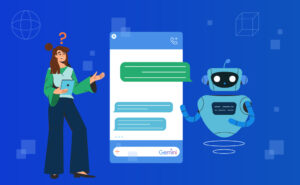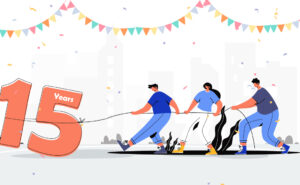Here is something that should be pointed out right at the outset – the B2B Sales Funnel is and will always remain an important area for marketers and sales folks, something that both sides will continuously try and improve. Despite very loud claims of the sales funnel of b2b being dead today, it is very much alive and will continue to be an important guard rail for how a customer behaves along the buying journey. And hence, it will continue to be important for both B2B marketers and sales folks.
Now let us make one thing clear – there is no one consensus on what is the right sales funnel. It is also interchangeably used with the terms b2b sales pipeline, b2b customer funnel, buyer journey, sales cycle, purchasing process etc. While the marketing folks like to consider the b2b sales funnel as a visual representation of how a customer behaves from the time of becoming aware of a product to the time he makes a buying decision, the sales folks like to consider it as a series of steps to turn a consumer into a buying customer.
So, in this article, we try to understand the following –
What is a B2B Sales Funnel?
Very simply put, a sales funnel is a model that helps us understand the ideal path that a customer or a prospect takes in relation to your business. In effect, the funnel is like a guide that helps us understand how a potential customer moves from basic knowledge of a product/service to actually taking a decision – that is purchase a product or service from a brand. This helps marketing and sales to focus better on what should be the next steps in order to get a customer to convert.
So, what are the different stages of a B2B sales funnel or lead funnel. As explained earlier, the stages might vary for different brands based on the strategies chosen. But, in general, these are the main stages of a B2B sales funnel.
What are the Stages of a B2B Sales Funnel?
There are 4 main stages of the b2b sales funnel. Let’s understand what each stage means.
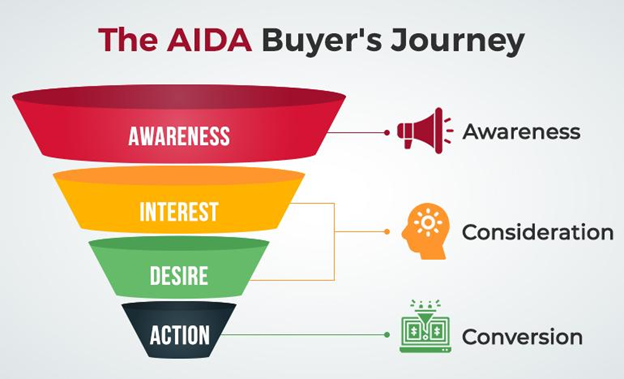
1. Awareness
In this stage, the prospect experiences a problem or need. He is not well aware of the exact problem but he sets out to seek help. He seeks for a solution through various channels like Google search. He comes across several sources like blogs, social media posts, awareness ad campaigns. He understands the need or problem more effectively. He consumes non-gated content (for which you do not share any information in exchange for the content) in this phase.
2. Consideration
In this stage, the prospect has a clearly defined problem or need. He considers all the available options to find the best solution. They consume gated content and register themselves with you in exchange for more information. It is essential to gain buyer’s data like name, mobile number or email to nurture them through email marketing or similar practices.
3. Decision
In this stage, he has finally decided on the solution, method or approach to his problem or need. He has made his buying decision, which will solve his need.
4. Action
This is a culmination of the previous stages and the consumer either goes ahead and buys the product or rejects it.
Why the Sales Funnel is Not Your Buyer Journey?
Since are talking about the sales funnel here, it’s very important to mention that the b2b sales funnel is not the same as the buyer journey. In the past, the buyer was simply dependent on the sales person to move through each stage of the sales funnel. The lacked any sort of data and were under pressure from the seller to buy a product. You could say that the seller controlled the process and the buyer was more or less passive in the whole process, being dictated by the vendor. Hence the push-push AIDA model worked.
Today, that process has undergone a sea change. The buyer can no longer be forced by the sales folks into moving through each stage of the sales funnel like before.
The buyer today has an incredible amount of data in his hands. Today, once a buyer enters the awareness stage and becomes aware of your brand, she moves into the CONSIDERATON stage where she starts checking out several other brands too. She moves back and forth between your brand and other brands, until she finally finds something from each brand that convinces her to make a purchase.
Hence, the buyer’s journey is no longer a funnelled approach. It is more like a loop, where the customer goes back and forth, considering and reconsidering there decision.
Infact, researchers working at Google brought out an excellent paper about this same theory in 2020. According to Alistair Rennie and Jonny Protheroe, who work on Google’s consumer insights team in Great Britain, the consumer’s journey is no more linear. It’s a chaotic process they call as the. Messy Middle, in which the customer needs more and more information to decide on the purchase.
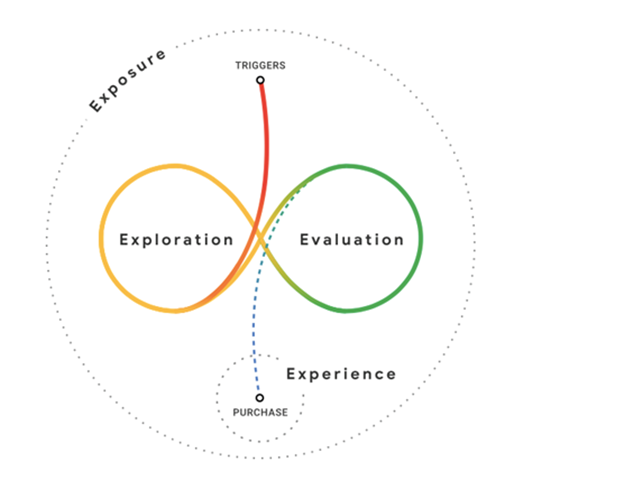
Read more about what the Messy Middle means in our blog What is the Buyer Journey Today and How to Incorporate Content into it?
This is what has led many marketers to claim that the sales funnel is dead. However, that is not true. That is simply because the b2b sales funnel is not the same as the buyer journey. The sales funnel is more a model as to how the customer should ideally move from the awareness stage to the purchase or action stage. It is supposed to act as a guide. The actual buyer’s journey is far far more chaotic than that. It does not follow a funnelled approach.
Hence let’s get this straight –
The sales funnel is not the same as the buyer journey.
But that does not mean the sales funnel does not work anymore. It is alive and working, as long as you do not confuse it with the buyer journey.
The b2b sales funnel is an inextricable part of the b2b sales process. It helps the sales and marketing folks of a company plan their activities better and understand how to advance a prospect further into a sale.
If You Run a B2B Business, You Live or Die by Your Sales Funnel
B2B sales funnel need to be well-structured as it is clearly stated that you live or die by your sales funnel. So, you create more sales by identifying the prospects’ actual needs, choices, and tastes. This way, it will be easy to understand what you as a business have to do to refine your sales process once you are confident about what your prospects are looking for and what might steal their attention and interest.
This is only helpful if you acquire a more profound knowledge of your customer’s journey. Understanding your prospects will help you gain genuine leads, ultimately improving your business sales.
Despite the fact that sales funnels, if used properly, can help maximise sales of an organisation, many businesses, i.e., 68 percent of them, end up using them wrongly.
Let’s deep dive into how a lead moves through the different stages of the Sales Funnel
How a Lead Moves Through Different Stages of Sales Funnel ?
Consider that a SAAS company is in need of a content marketing agency in Gurgaon. You are a content marketing agency in Gurgaon. Let’s understand how a B2B funnel works, considering this example.
1. Awareness or Lead Generation
At the top of the sales funnel, remember you are dealing with a random user unaware of your product. They may not even be aware that they are in some misery, let alone that a service exists to assist them. The purpose of this step is to figure out how to attract potential clients while also building your authority. Understanding your ideal customer is the key to converting the prospects into potential customers, i.e., improving your b2b sales funnel conversion rates with high-quality leads.
In this stage, awareness campaigns are run in the form of non-gated content like blogs, newsletters, social media posts, paid advertisements etc. The motive is to spread awareness about the product/service and get maximum eyeballs or traffic.
Example of Sales Funnel Marketing Strategy in Awareness Stage
Let’s get back to the SAAS company example. The company is struggling to reach out to its right audience and build its sales funnel and hence is trying to find a solution – in this case a content marketing partner. They search for the best content marketing company in Gurgaon. Your company’s website shows up in Google Search because of a pillar page (a long landing pages) that has been written related to “content marketing for SAAS companies”.
They might also have found you through the blog “best content marketing strategies for B2B companies” which you have been promoting on Facebook and Linkedin. This is how your prospect entered the AWARENESS stage of your sales funnel.
Also Read: Linkedin vs Facebook :How to Use This Platform for Business Purpose
2. Interest – Time for Lead Nurturing
It is a proven fact that the B2B sales funnel is all about presenting things to consumers clearly and concisely. If you keep pushing yourself to the lead over and over, there are chances that the deal will slip away from your hands. And, if you keep procrastinating things and information about the leads, there are chances they might lose interest and choose your competitors over you.
As a result, the challenge at this stage is to guide and acknowledge additional prospects who aren’t ready to invest in your products while recognizing others who are.
No matter how complex your sales process, moving a lead from one step to another might take anything from a few weeks to months.
Example of B2B Sales Funnel Marketing Strategy in Interest Stage
Once your customer knows about you, they will want to know more about you. This is where you should nurture your lead through various types of personalized content. Basically, you work on developing an interest in your lead about your product or service.
The SAAS company landed on your website and read the content of your pillar page. From there, a popup offered him a free ebook in exchange for the newsletter sign up. The lead now wants to know more and signs up for the ebook.
Now, the lead has entered into the INTEREST stage of the funnel.
3. Desire – Time for Meeting
In this stage, a lead is warm, and has an interest in your product or service. All you need is to provide them with the right deal at the right time and convince them that you are the right partner for them. Case studies, webinars, and email newsletters are vastly used in this stage to prepare a customer for purchase.
It is also the perfect time for a first call or meeting to build the crucial relationship and trust required to convert a prospect into a customer.
This is most likely the most crucial step of the B2B sales funnel since the initial sales discussion will determine whether or not the customer moves on to the next stage of the funnel.
Example of Sales Funnel Marketing Strategy in Desire Stage
Continuing our example above, the content marketing agency now uses the email id of the SAAS company to start a well-planned drip email campaign. The SAAS company now gets emails from the content marketing agency that drives them towards case-studies, testimonials, and other well-thought offers designed to convert the lead. The sales team from the agency also establishes first contact with the SAAS company through a call.
This arouses DESIRE. Finally, the SAAS company requests a quote from the content marketing agency. Hence the lead gets promoted to the last step of the funnel.
4. Action – Time for Closing
Everything comes together at this point. The ultimate goal of this sales funnel is to get the prospect to the last stage. This is the narrowest point, where your prospect turned into a potential consumer is on the verge of making a definitive decision about whether or not to collaborate with you. However, something is preventing them from taking the final step.
There could be a variety of reasons for this:
- Comparisons between you and your competitors
- Few unresolved queries
- Last-minute evaluation of your proposition
- Aligning priorities
- Securing commitment
- Keeping the business connection
Example of B2B Sales Funnel Marketing Strategy in Action Stage
So, you have the prospect ready; he is interested and has the desire to buy from your brand. All you need to do is offer him the best deal and the deal is done.
Moving ahead with our example, the content marketing agency offers a lucrative pricing to the SAAS company and tweaks the set of deliverables that work for both. Both sides discuss and close the deal.
Finally, the deal gets done and the prospect is converted into a client. ACTION is taken and the prospect comes out as a customer.
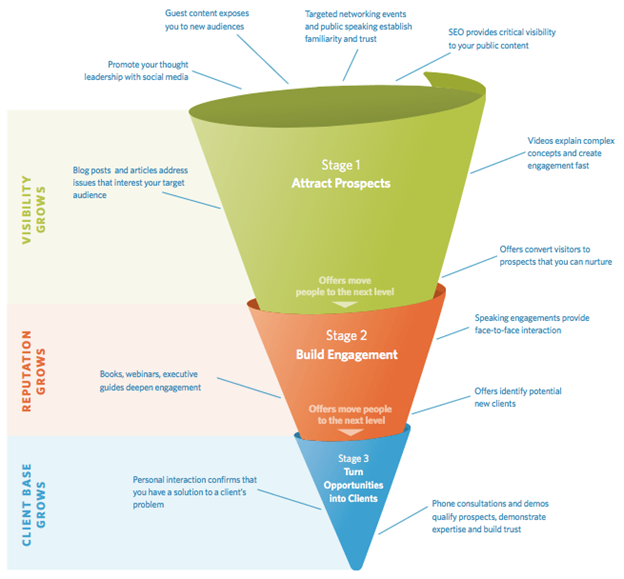
Source: Hinge Marketing
How to Build Sales Funnel for Your Business ?
Interested to learn how to build a sales funnel? Let us understand the steps to creating one for your business.
1. Understand your Customers
Who do you want to attract to your sales funnel. The more you understand your prospect customer, the better is the effectiveness of your funnel. Remembering you do not want to be marketing to everyone. You want to find a customer who is a good fit for what you are offering as a company. You do not want everyone as your prospect customer.
Here are somethings to understand about your customer –
a) What is their pain point and what solutions are they seeking?
b) Which channels do they use?
c) What goals are they trying to reach?
d) What have they done to solve their problems?
All this knowledge will help you refine the buyer persona of your target audience and help you target better.
2. Attract the Attention of your Customer
Once you know who is your target audience, you start to attract their attention. A sales funnel works only if you have prospects in our funnel. So now your job is to attract your target audience by creating awareness about your brand.
For this you can adopt the following measures:
a) Start by writing well-optimised blogs and pillar pages that solve the queries of your target audience. (At the top we talked about how the content marketing agency attracted the attention of the SAAS company through blogs). Make sure you use keywords that have an informational intent (for eg: keywords with how, where, why, etc) first.
b) Run a PPC campaign
c) Invest in a good SEO campaign that will help your website appear on the first page of Google for the keywords that your target audience are searching.
d) Invest in publishing insightful guest posts on high DA sites.
e) Start by creating good social media content and then do social media marketing. This will help build awareness for your brand organically and help create that first level of touch with your customer. This is one of the most important reasons for doing social media, which customers often ignore.
3. Ensure Communication with the Prospect at Every Stage and Offer the Right Content
Its critical to ensure that as your prospects embarks on the buyer’s journey, he or she receives the right sort of engagement or communication at every point.
This communication or engagement is critical to move the prospect down the funnel.
It is very important that the right kind of content or communication is provided at each stage. The content you would provide to a prospect at the awareness stage cannot be the same content you provide to him at the Action stage.
It does not matter which sales funnel process you apply; the important thing is you create the best buyer experience. At every part of the buyer journey, you must empower your prospect with the right kind of knowledge and information that he will not get anywhere else. This is what will help develop trust between the prospect and your brand and influence him to purchase from you.
Also Read: 40 Awesome Brand Taglines that Will Stick to Your Brain for Good!
4. Keep Adjusting your Funnel and be Relatable to your Prospect
Yes there is a structure to the sales funnel, but your team should know when to follow a process and when to relate to the customer and change the structure. In this age of micro-targeting and hyper-personalisation and customisation, the sales process should be adaptive to the needs of a buyer.
Here are somethings you can do to make your funnel more effective.
- Ask your existing clients what was the most helpful in the sales process, and what they felt was unnecessary. Was there any way the experience could have been better?
- Do not be afraid to ask your prospect more about their business. More information might help you convert him faster.
- Try to find how many sales funnel conversions are happening at each stage. The b2b sales funnel conversion rate will help you understand if there is any tweaking needed in the content/communication/sales processes at any particular stage.
Also Read: Want Conversions? Learn the 7 Most Effective Principles of Blog Design
Sales Funnel Expert Insight
We asked our CEO to share her thoughts and insights on B2B sales funnels. Here you go.
Payel Mukherjee: CEO of Justwords
Do you think the sales funnel is relevant in today’s world?
Sales funnels will be always relevant since its helps the marketing and sales team to be more focussed on the activities and programs they are planning for each stage of the customer’s journey. Most people confuse the funnel with the buyer’s journey. As long as you use the funnel as a guard rail for the customer’s ideal purchase path, you are good to go. It helps you understand what kind of content you need to put out at every stage, what is working and what is not, and what needs tweaking. In actuality, the buyer’s journey is much more chaotic and is not a funnelled journey.
What are the secrets of running a working b2b sales funnel?
Well, you need to keep analysing and adapting your sales funnel. By this I mean, you need to more about your buyer, and their purchasing process and adapt the content and strategies that you are putting out at each stage as per that. You need to which channels your B2B buyer prefers, before you send him out that content. The most useful communication is the one that is sent to the buyer on the channel he prefers most.
Still have questions about the B2B sales funnel and how to build the most efficient content to make your funnel most effectively, reach out to our Justwords experts directly.


